This site contains affiliate links. As an Amazon Associate, I earn a commission from qualifying purchases at no extra cost to you. Full Disclosure Here.
The drop point blade shape at first can look very simple and intuitive, but that’s probably because you’ve used them before and have seen them often. Disregarding our previous experiences with knives altogether, the drop point is actually an incredible design of balance and strength that most would consider one of the best blade shapes for well-rounded general use.
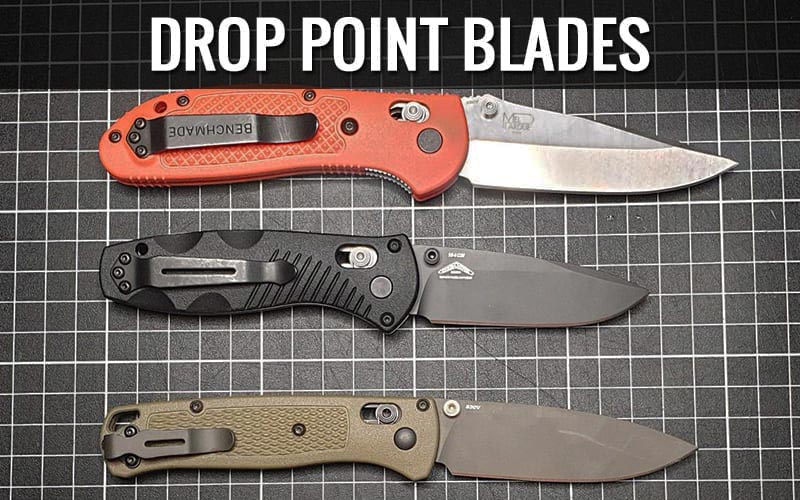
In this guide, we’ll be going over what makes the drop point so popular and so handy as well as putting it up against some of the other popular knife blade shapes you might be considering. We’ll be discussing the advantages, disadvantages, and how it performs for specific use cases. The shape of your blade is a huge determining factor in how the knife performs across a multitude of tasks and so it’s extremely important to understand the pros and cons of any given blade shape!
Explanation of the Drop Point Shape
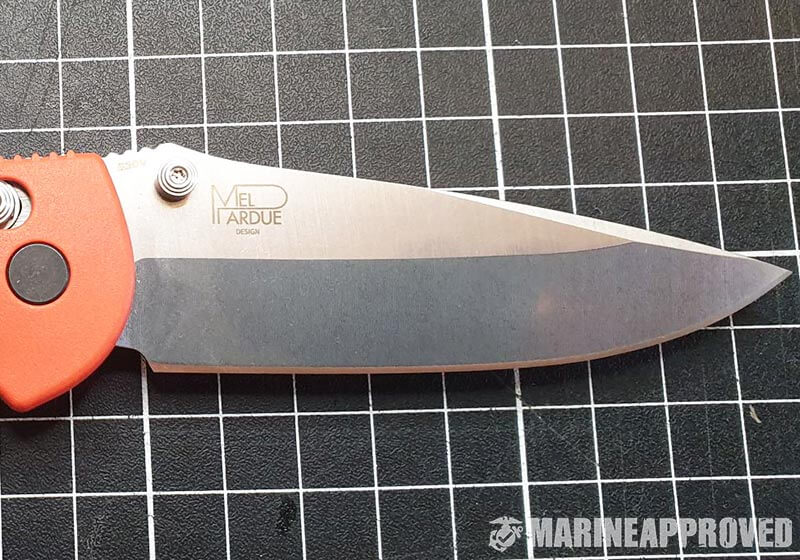
Design Overview
The drop point encompasses a design where, starting at the top and from the handle, the blade gradually slopes down into the point. At the bottom along the edge, a drop point will consist of a mostly flat and straight section that, after a nice cutting surface has been established (usually referred to as the belly), also gradually slopes upwards a bit more drastically than the angles of the spine until it gets to the tip.
Another important characteristic of the drop point is that, on almost all iterations, the tip is rather thick and encompasses quite a bit of steel material behind it, both on the top and bottom, to ensure it retains a large amount of strength and durability. Now, this certainly does make the drop point a bit less agile and not as great as some other shapes for intricate work in tight spaces, but overall, the drop point makes for a great everyday carry (EDC) option because the tradeoffs are negligible compared to its versatility.
Of course, the drop point has been around for a long time now and many knife manufacturers have drop point offerings in their own variations. There are several iterations of the drop point you might come across which includes drop points that have different swedges. A Swedge is that top portion of the blade that is unsharpened, however, may be ground down to be a bit thinner than the center section of the blade. There are many different types of swedges that can throw off the appearance of a drop point to a newcomer. As a general rule of thumb, the thinner the swedge, the lighter the knife, and the easier it will be to make deep and accurate cuts but the thicker the swedge, the more durable and stronger the blade will be.
Some drop points will have a tighter and more pronounced slope on the cutting edge, leaving less of a straight portion of the belly but a much larger sloping section of the cutting edge. This is usually dependent on the blade length itself, whereas shorter blade lengths will appear to have more of its cutting surface along the sloping section as opposed to a longer blade length, which will have more of its total cutting surface in the form of that straight portion of the belly.
Typically, pocket knives on the smaller end of the spectrum will appear to have a more sloping cutting surface while larger knives, like a survival-style fixed blade, will usually have a much larger cutting surface along the straight portion of the belly.
Of course, the blade shape’s appearance may also be altered slightly with the type of grind that has been put on the blade, which we’ll talk about in more detail below. The point here is that, although drop points are very popular, the range of drop point aesthetics and designs can vary quite a bit and sometimes trip up even those who have been into knives for a long time now.
Modified Drop Points Explained
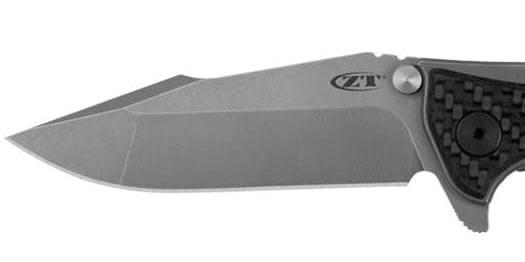
To make matters even more confusing, there is a whole subcategory of the drop point shape dubbed “modified drop points”, which don’t really follow the traditional rules of a drop point but perform and are aesthetically more similar to a drop point than any other blade shape. A good example of a modified drop point would be featured on the Zero Tolerance 0393GLCF, where they’ve cut out a portion of that top sloping area of the blade to create this ominous and somewhat thinner drop point, that I imagine is mostly just for the aesthetic appeal.
Something quite common you may come across is jimping or notches along the spine of the blade. The drop point shape is among the most common shape designs to be used with jimping, partly because the drop point doesn’t have a sharpened spine and is never double-edged, so jimping simply makes sense to be included, especially on larger knives. Jimping is added to make the knife easier to grip, offering deep notches or grooves right where you might put your thumb, to increase the knife’s nimbleness and control or aid in cutting through very difficult materials.
Something similar to the jimping that drop point blades are commonly found with is a choil, which is simply an unsharpened cut-out indent near where the blade meets the handle which may act as an option for grip or simply a stopping point during sharpening.
By the way, the drop point blade shape is actually among the easiest to sharpen and maintain, which only further establishes itself as one of the more user-friendly and durable blade shapes on the market.
A final note here, drop points are among the most popular blade shapes to receive both full serrated blade options as well as partial and half-and-half serrated options. It’s not the only blade shape to make good use of serrations but for many, having a ton of models that utilize serrations is the icing on the cake in terms of having options and versatility.
Drop Point Use-Case Assessment: Benefits and Drawbacks
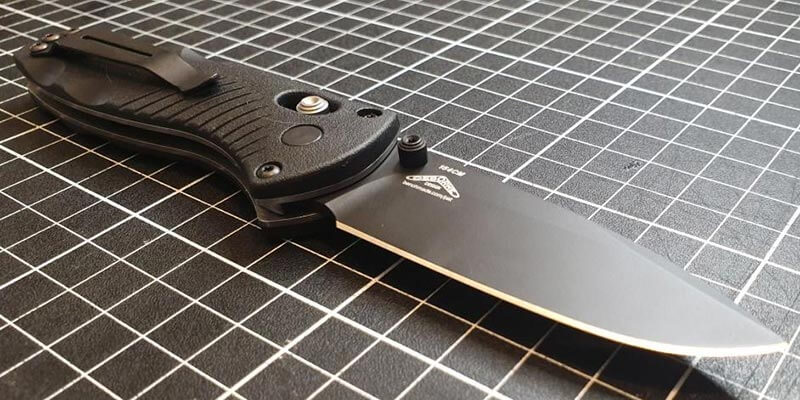
In this section, we’ll be discussing what drop points are good for, as well as their benefits and drawbacks.
Drop Point Blades for Slicing and Skinning
Score: 8/10
Drop points are some of the most popular knives you’ll find on a hunter and outdoorsman and for good reason, these knives make an all-around great utility knife when need be but also perform rather well when used to clean game and field dress. The drop point isn’t technically the best to play this game, however, it is more than usable for the hunter that also relies on his knife for a multitude of other uses and doesn’t want to carry along a specific knife just for skinning. Trailing points and clip points generally offer better overall skinning performance, but only marginally.
Drop Point Blades for Stabbing and Puncturing
Score: 5/10
A drop point blade can be used to stab or puncture but that’s really not its primary focus. Of course, the tip is sharp and pronounced, and overall, it’s pretty strong because it has a lot of material behind it, but that additional strength comes at a cost, a cost of which includes creating a tearing effect through its additional surface area in contact with what you’re trying to pierce. Daggers, clip points, and tantos generally offer much better piercing capabilities, but it’s not to say that you couldn’t do some damage with the drop point if need be.
Drop Point Blades for Batoning
Score: 9/10
Drop points, given a sturdy and thick grind like a convex grind, are among the best batoning blade shapes because they generally host a long and flat belly with a ton of cutting real estate but also generally contain very thick spines that beef up the blades strength and heft. Of course, some machete styles are going to be your ideal choice for batoning as there are machete designs specifically meant for this, but drop point blades on thick knives specifically meant for heavy outdoor use are going to perform almost just as well, but also have that additional versatility over your traditional machete.
Drop Point Blades for Slashing
Score: 6/10
Slashing with a drop point generally yields pretty fair results as the blade has a lot of sharp surface area in a shape that makes being accurate a bit easier. Of course, there are nuances here that are tough to really explain. Slashing, for example, through thick brush, is rather easy with a large and sturdy drop point knife, however, there are machetes specifically designed for this task that may perform slightly better. Slashing in a self-defense situation is very easy with a drop point, but the drop point won’t have a dragging-in effect like a hawkbill, or Karambit, so you’ll need more force with a drop point to do a similar amount of damage compared to those two and the drop point doesn’t have as pinpoint of a tip as a tanto, so it won’t be able to cut through thick materials as easily.
Drop Point Blades for Whittling
Score: 7/10
Most of us probably first learned to use a knife in the outdoors whittling away at little sticks we found and we probably did it with a drop point blade. The thing is, drop points offer an excellent cutting surface that makes taking off a good amount of material very easy and the controllability of the drop point is unmatched until you need to take off that bit of bark deep between the pit of your stick and a branch you for some reason want to leave on, and now you have a blade that’s too thick at the top you really get into that crevice and get your work done. This is where something like a clip point might outperform a drop point and of course, you don’t really need the excess material behind the tip that makes the drop point so strong because we’re whittling, not wacking or hacking.
Drop Point Blades for Prying
Score: 9/10
Let’s preface this by saying that knives are not prying tools, but of course, if you’re buying a hefty drop point, the idea is to be prepared for pretty much anything, and if you have to pry with no access to something meant for prying, something thick and beefy like a survival-oriented drop point is probably going to be among the best options you have in the world of knives. That extra material that makes drop points so thick and hefty, especially around the tip, is going to provide much more strength and durability than almost all other blade shapes and thus, makes a drop point that is designed for heavy use one of the best options for prying overall.
Drop Point Blades for Everyday Carry (EDC)
Score: 10/10
Drop points are simply the best in terms of EDC. The very idea of EDC knives is to carry something that allows you to be prepared for whatever life may throw at you. Maybe you’ll need to open up some boxes in the morning, cut through some speaker wire in the afternoon, slice up some fruit for dinner, and then deploy your knife for self defense later in the night. Although not the absolute best for any of those, a drop point will get the job done with relative ease and peace of mind.
Drop Point Blades for Camping/Bushcraft
Score: 9/10
If you could only bring one knife with you to explore the depths of a forest or set up camp on an island isolated from the stresses of society, the drop point would be the obvious choice. Simply put, no other blade design is going to offer you the multitude of versatility and utility in and around the campground and when it comes to bushcraft, the best knives out there are going to come in the form of a drop point. If you’re interested, check out favorite camping knives and fixed blade knives here. Almost all are available with a drop point blade.
Drop Point Blades for Fishing Line/Ropes
Score: 8/10
Grab yourself a serrated or partially serrated drop point and you’ll be destroying ropes and fishing line with ease. Most people in their tackle box are going to have a drop point that they use for these kinds of things, however, there are knives that may perform better, such as a Hawkbill. A serrated hawkbill works wonders when cutting rope that you might be holding in the air or loose fishing line hanging off the end of your pole while something like a Wharncliffe would make cutting rope/fishing line that’s lying flat on a solid surface very easy. This is kind of situational, but overall, the drop point will work just fine.
Drop Point Blades for Self Defense
Score: 5/10
In this day and age, you really don’t want to be using a knife for self defense at all, but if you have to, and the drop point is what you have on you because of its other amazing capabilities, then its certainly better than nothing and when utilized correctly, will most definitely do considerable amounts of damage and can incapacitate an attacker. Of course, there are many blade shapes that are preferable in a self defense situation, such as a clip point, tanto, or spear point due to their better performance in piercing capability or the karambit, which delivers devastating damage to flesh because the shape naturally pulls the blade deeper into your attacker.
Drop Point Blades for First Response/Egress
Score: 10/10
Since first responders can face a very wide variety of situations that they may have very little information on before arriving on the scene, the drop point is going to be one of the best options simply due to its versatility and durability. Many drop points come with helpful features like serrations that can make cutting away clothing for access to wounds or slicing through seat belts to drag out the occupant of a car crash very easy. The drop point is so popular among first responders that there are brands that make drop point-shaped knives specifically for this use-case, such as the Benchmade Tactical Triage. There are some styles of modified drop points where the very end of the tip is removed or blunted to ensure no accidental piercing when working in close proximity to someone in need.
Drop Point Blades for Combat/Tactical
Score: 7/10
The debate about combat knives is kind of strange because in almost all cases, our operators out in real combat zones are not going to be using their knives for violence, but more so for their supportive attributes such as cooking, setting up camp, triage, weapon or other gear-related maintenance, and so forth. Knives are used more like a tool than a weapon, even in the hands of some of the most deadly individuals on Earth, and so when it comes to the drop point, it’s very popular to be carried by those in combat zones. Of course, as a last resort, having something like a tanto with its better capabilities to pierce low-level body armor and thick clothing as opposed to a drop point would make sense, or having a clip point or spear point for their obvious performance in stabbing would also make sense. At the end of the day, you’ll find a wide array of blade shapes carried by soldiers and for the most part, the drop point is still incredibly popular due to its versatile nature and ability to be ready for just about anything.
Drop Point Blades for Cooking
Score: 10/10
Most cooking knives, unless super niche or specialized are drop point blades, so it makes sense that if you plan on doing any food preparation with your knife, to get a drop point blade shape. Simply put, they are excellent among pretty much everything from opening up packages to slicing up your veggies to cutting up your steak, and so on.
Drop Point Use Case Assessment Table
| Use Case | Overall Score |
| Slicing and Skinning | 8 out of 10 |
| Stabbing and Puncturing | 5 out of 10 |
| Batoning | 9 out of 10 |
| Slashing | 6 out of 10 |
| Whittling | 7 out of 10 |
| Prying | 9 out of 10 |
| Everyday Carry (EDC) | 10 out of 10 |
| Camping and Bushcraft | 9 out of 10 |
| Fishing Line and Ropes | 8 out of 10 |
| Self Defense | 5 out of 10 |
| First Response and Egress | 10 out of 10 |
| Combat and Tactical | 7 out of 10 |
| Cooking | 10 out of 10 |
Drop Point Versus Other Popular Blade Shapes
Drop Point vs Tanto Blades
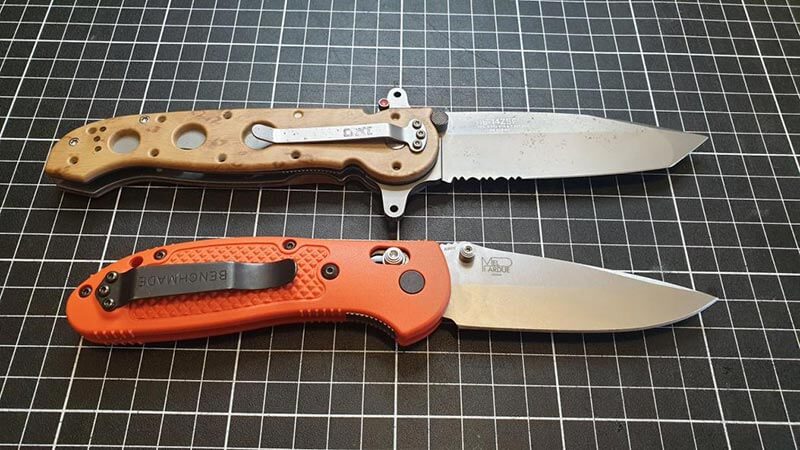
The Tanto is going to outperform the drop point in situations where piercing capabilities are the most important factor. The Tanto blade was specifically designed to pierce soft body armor and thick clothing with a very pronounced and strong point that is exceptionally sharp and thin, allowing it to pierce but giving it strength to endure heavy action. The drop point simply has too much additional material around the point to allow it the ability to slide in deep with the same amount of force. Of course, the Tanto is nowhere near as user-friendly when it comes to a multitude of other tasks, such as survival, cooking, bushcraft, etc, so the drop point is obviously a much better choice for pretty much everything except piercing and stabbing.
Drop Point vs Reverse Tanto Blades
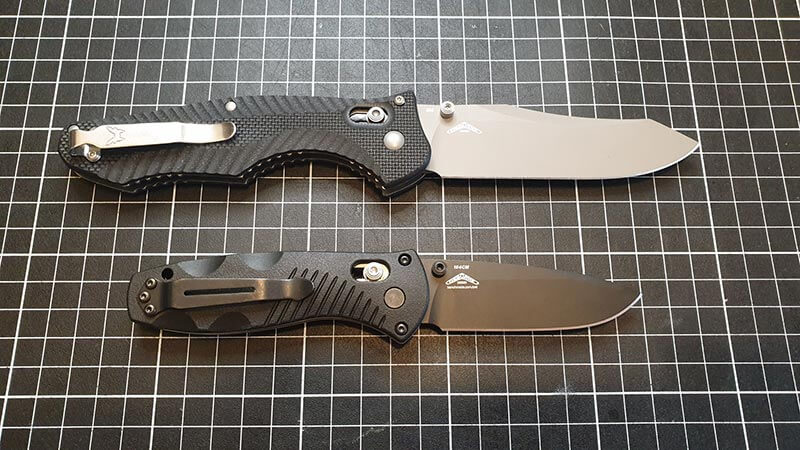
The reverse Tanto actually does a very good job at blending in the long and versatile cutting belly of the drop point while creating a well-established piercing tip. Reverse Tanto blade shapes are not nearly as popular or available as a drop point but in the future, I think they’ll become more popular as they really do have basically the same amount of utility function as the drop point but also give you a bit of an advantage in situations where you’d need to pierce or make thin and precise cuts with the tip of the blade. Of course, the drop point has a bit more overall durability just from having more material near the tip, but not by a great deal.
Drop Point vs Clip Point
The clip point utilizes a similarly long and sloping cutting belly that makes for a great range of utility use cases but has some of the material on the spine near the tip removed, making it easier to get that tip into smaller and tighter spaces and also provides for a bit easier penetration when used while stabbing or piercing. For the most part, these two are almost interchangeable, but the drop points tip should, when comparably as thick, have a bit more strength since it has more material throughout the entire blade.
Drop Point vs Trailing Point
The trailing point is a favorite among hunters and fisherman for its exceptional and precise skinning capabilities, but of course, it’s nowhere near as strong and durable as a drop point and so it’s not as reliable in all-out survival, bushcraft, or self defense situations.
Drop Point vs Wharncliffe
The Wharncliffe has no slope along its belly so it’s really only great for cutting things that are on a flat surface where you need to make a clean and straight cut downwards. In many cases, the Wharncliffe might outperform the drop point when making shallow, straight cuts, but generally lacks penetration or deep cutting capabilities in comparison. Some Wharncliffe blades have a very tight and sharp tip that makes for pretty good slashing capabilities as well, perhaps better overall than a drop point.
Popularity and Accessibility of the Drop Point
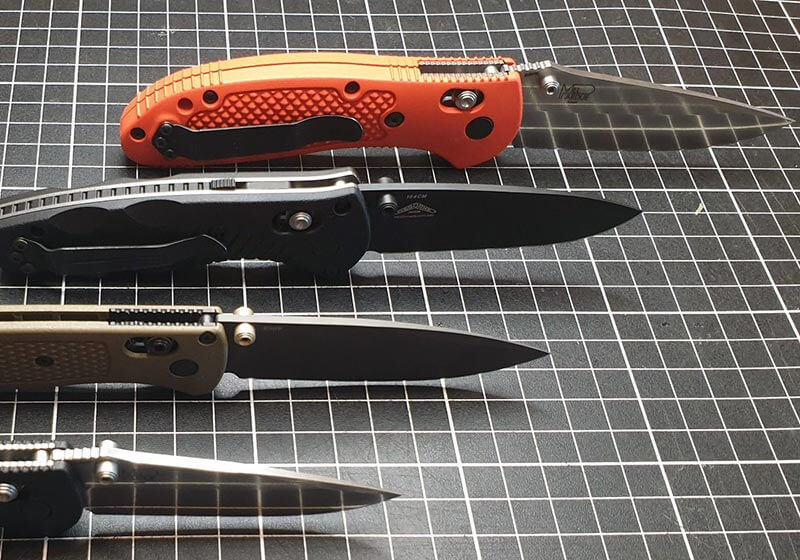
If you walk into literally any store at all that sells knives, you are guaranteed to find something with a drop-point blade shape. Simply put, drop points are probably the most popular and most abundant style of blades being manufactured today because they are easy for people to use, they don’t have weird legal gray areas or all-out bans in most places like spear points, karambits or dagger styles may have, and they are among the most versatile as we have already mentioned.
Drop point shapes are popular among almost all types of knives, including EDC, utility, hunting, camping, survival, tactical, cooking, and more.
Common Grind Types for Drop Point Blades
If you take a look at the Marine Approved guide on knife grind types, you’ll notice that almost all of our examples given for each grind are, in fact, drop points or modified drop points! This is because the drop point shape is one of the easiest blade shapes to be given a wide variety of grind types and to be frank, pretty much all grind styles can be utilized on the drop point and the choice of grind becomes more of a question of the design and intended use-case of the knife.
Since the overall idea of the drop point shape design encompasses this idea of “do it all” versatility and utility, it would make a lot of sense to grab a blade using the flat grind, saber grind, Scandi grind, hollow grind, or V-grind, although each of these grinds do have their own pros and cons so make sure to check out the guide on these above. All in all, I would say the flat grind is probably going to be the most common and the most versatile overall, but the grind you choose should match up with how you plan to use the knife.
Marine Approved Folding Drop Points
- Benchmade Bugout
- Spyderco Moran
- Cold Steel Recon 1
Marine Approved Fixed Blade Drop Points
- Fallkniven A1
- ESEE 4P
- Ontario Knife Company Rat 7
Wrap Up
Writing this guide, especially in regards to finding the drop point blade shapes pitfalls and inadequacies was really difficult because honestly, for most people using a knife for their regular day-to-day operations, a drop point is going to be good enough no matter what, but there are always nuances. It’s pretty difficult to find yourself in a situation where you think “wow, I really wish I didn’t buy a drop point blade” because all in all, a solid drop point on a knife from a reputable brand should hold up and endure pretty much anything and everything you throw at it. Think of the drop point as a Jack of all trades but master of none kind of blade shape.
Sure, there are some special circumstances where other blade shapes may fair better and have an overall better performance doing one specific thing, but in terms of utility and versatility, no single blade shape comes close to the beloved drop point blade and all it can accomplish.
Of course, blade shapes are only one of many considerations when choosing the perfect knife and if you’re looking to expand your knowledge before you pull the trigger on something new, check out the Marine Approved guide on blade steels and then head over to our guide on handle materials to make sure your new knife is both handy and comfortable!
